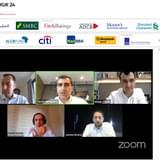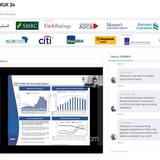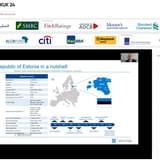What is your outlook on the performance of the Turkish economy at present and how will this evolve going forward?
Volatility is the first thing that one perceives when looking at the Turkish markets, but at the same time, the country has a growing market. For the last two years, Turkey has recorded a growth of around 3-4% GDP growth (3% in 2014 and 4% in 2015) and the economy is still growing. In the first quarter of this year growth touched 4.8%, which was driven mainly by domestic consumption.
Currently, leading indicators such as PMI and IP are pointing to a slowdown for 2Q; our estimates are at +2.9% year-on-year. The recent performance of Turkey’s economy has, however, been achieved despite significant market volatility driven by both political developments as well as global trends throughout this period, such as the coup attempt, currency depreciation, geopolitical tensions, Fed rate hike expectations, Brexit related volatility and a broader slowdown in Europe.
Although these recent events will adversely impact growth, our expectation is for GDP to grow within the range of 3-4%, at around 3% for 2016, which will be easily manageable in the current environment and is still above peer countries such as Brazil, Russia and South Africa.
The outlook for Turkish growth also appears positive when considering the global geopolitical situation and monetary policies worldwide. For example, improving relations with Russia since the beginning of the summer is very encouraging, while persistently low oil prices are still positive for Turkey.
As of July, inflation stood at 8.8% due to high food prices and FX pass-through from the depreciation of the Turkish Lira. We expect inflation to be around 8% by the end of the year. The current account deficit to GDP, one of the key focus areas in Turkey, is also very much under control. Our expectation for 2016 is around 4%, compared with 4.5% in 2015. Fiscal discipline is also stable, with the budget deficit to GDP at a very healthy level of -0.8% (vs -1.2% in 2015) despite numerous elections over the last 2 years.
It is also important to stress that in this environment the Central Bank has been very supportive. The CBRT eased monetary policy with a rate cut cycle on the overnight lending rate beginning in March, which has reached 225bp on a cumulative basis as of September; the level is currently at 8.5%. Depending on the inflationary outlook for the rest of the year, additional rate cuts might also be on the CBRT’s agenda.
Overall, I am positive about the general economic outlook for Turkey because despite volatility, there is a high capacity within the country to react quickly to changes not just in the financial sector, but in general.
What is your outlook on the country’s banking sector?
Turkey is a country with a large and young population – the country has more than 70 million people with an average age of 30. This means the country is very dynamic and has the ability to grow quickly. Lending penetration is still low compared to EU averages despite rapid growth over the last five years. Loans to GDP in Turkey is currently at 73% vs the EU-27 average of 114%, meaning there is still a lot of room for growth in the country’s banking sector.
Accordingly, we believe that the Turkish banking sector has significant growth potential and profitability in the long-term. In addition, the fundamentals of the sector are strong, with resilient capitalisation levels and solid liquidity and asset quality.
We believe that with GDP growth of around 3-4%, the Turkish banking sector can continue to record around 10-13% loan growth for the next couple of years. At the same time, we believe that the profitability of the banking sector, which has been pressured by macro-prudential measures introduced by the BRSA over the last couple of years, will remain solid.
During 1H2016, the sector’s profitability ratios have increased significantly, driven by sound core revenue generation, disciplined cost management and a healthy LLP trend. In 1H2016, sector ROAE (return on average equity) was 14.9%, compared to 11.5% in 2015, which is significantly higher than the levels seen in developed countries.
One of the key trends that we expect to see in the upcoming period for the banking sector is an increased focus on digitalisation and optimisation efforts by all the banks, in line with trends globally within the banking space.
This is an area where many Turkish banks and especially Yapi Kredi Bank are already very strong; we will continue to focus on this space to ensure both customer satisfaction and sustainable profitability going forward. This is especially important given the young population in the country and the rapid pick-up of new innovations by customers.
How liquid is the Turkish banking sector?
Given the solid profile of the banking sector in Turkey, as well as the expected positive evolution of the macro environment, we believe that liquidity in the country’s banking sector will remain solid going forward.
Even when taking into account risk, capital ratios of the main banks in Turkey are in the region of 14-16%, a very strong level of capitalisation – which is also true for Tier 1 capital.
In the last couple of months, and especially following the coup attempt, the CBRT has been very proactive in terms of providing the necessary liquidity for banks, both in local and foreign currencies. Currently, Turkish banks are well positioned, however, if necessary, the CBRT is ready to take additional action in order to continue to support the sector.
The banking sector has a diversified funding profile, with significant portion coming from local deposits; 53% of sector liabilities are deposits. The CBRT also provides repo’s, which make up 6% of the system’s funding base. On the other hand, roughly 20% of the Turkish banking system’s source of funding is derived from borrowing, which include mainly syndications, bilateral loans, supranationals, TRL bonds, Eurobonds and subordinated debt. Most of the borrowings are foreign-currency denominated credit lines from abroad.
This year, as always, the banks have been able to successfully roll over their borrowings despite volatility in the operating environment. After the coup attempt, one of the major players in the sector renewed its syndication with a rollover ratio of around 100% and at stable pricing levels when compared to the beginning of the year.
How widespread are NPLs across the banking sector?
Over the last 2-3 years, and despite significant volatility, the sector has maintained an NPL ratio well below 4% thanks to a prudent approach both by the BRSA and the banks themselves. This is significantly lower than peer countries like Brazil at 8% and Poland and Russia at around 6%. In addition, Turkish banks also have conservative and high coverage levels at around 81%.
So far in 2016, there has been some asset quality deterioration in the sector but it has stayed within expected limits. It has been mainly driven by smaller tickets while company lending has remained very resilient. This also shows the strength of corporates within Turkey and their ability to adapt to challenging operating conditions.
Looking at the sector, NPL ratios currently stand at 3.2% as of mid-August compared to 2.9% at year-end 2015. Of course following recent events over the last few months we have seen a small deterioration in asset quality: Adjusting for NPL sales, the increase in the sector of the NPL ratio is at +40bp year-to-date, and has been impacted by the challenging operating environment as well as slowdown in lending, +10% year-on-year through a denominator effect..
For banks, despite the solid infrastructure and prudent lending practices already in place, one of the key focus areas is to continue to enhance monitoring, underwriting and collection methods, especially in light of new innovations such as digitalisation and big data capabilities. We continue to follow and enhance such practices.
How has Yapi Kredi’s overall strategy adjusted with the changing economic situation?
We believe in the long-term potential of the banking sector and we continue to support our customers despite challenges in the operating environment. Depending on the period, we do not change our strategy, but fine-tune our short-term approach in order to manage the environment in the best possible way.
Over the last couple of years, we have been focused on enlarging our customer base and strengthening our positioning in the sector. We acquired 1.2 million new customers over the last 2 years and we are currently serving more than 11.6 million customers within the country, which equates to 15% of the total population of Turkey.
In the current environment, while continuing to support our customers and growing our volumes in line with the sector, our focus has been on ensuring sound asset quality and liquidity. In both of these areas, we are currently well positioned as we continue to focus on digitalisation, simplification, efficiency gains and increased agility.
We are shifting our customer base from traditional channels to digital ones faster than expected. If the customers are using a smartphone, we have to provide our services through this channel, for example. It is important to have a good balance through the different channels.
So far this year, we have recorded net income of TRL1.552mn, which corresponds to a 62% annual growth and a cumulative ROE of 14%, driven by solid revenue generation, disciplined cost management and resilient asset quality.
How have lending operations at Yapı Kredi changed over the past year? How much of a role will the bank play in the markets in 2017?
We focus on growth while maintaining conservative and prudent underwriting principles. Over the past year, this approach has not changed.
Currently, our plans are to grow in line with the sector in 2016 and going forward, we will maintain our market position. This means we will continue to play an active role in the markets in 2017, both in terms of growth and the innovations we plan to bring on the customer experience front.
We are still investing in digital products and going forward we aim to attain both synergy and efficiency gains across our distribution channels.
How are the Bank’s funding requirements likely to change going forward?
We do not foresee any change in our funding requirements in the near future. Our aim is to continue to grow our loan book in line with our deposits in order to maintain a healthy liquidity profile and balanced growth rate.
We have a loan to deposit ratio of around 115%, and we believe that this should be maintained in the future. In the overall funding structure, we have lira and foreign currency liabilities, which are split 55-45% respectively.
In addition, we will continue to tap the international markets proactively to effectively manage the currency and duration mix of our funding base. We borrow in foreign currency mainly in subordinated debt or through syndicated loans. We have not seen any problems following the coup in the rollover of syndicated loans.
Going forward, we do not expect a significant change to the composition of our liabilities; deposits at 55%, repo at 5%, borrowing at 20%, SHE at 10% and other at 10%.
What factors, either internal or external could impact lending or borrowing operations at Yapi Kredi?
First of all, we are in a market where the regulator is crucial, and on this side we have seen both the CBRT and BRSA being very proactive in supporting the banking sector. Global financial conditions as well as geopolitical developments will also continue to affect the operating environment. All in all, we currently do not foresee any factors that would materially impact our operations.
As part of UniCredit we have the right support from our group, and the international markets are always interested in Turkey, providing further support.
How does the bank look to raise capital? When are the most opportune times to tap the markets?
We have a very solid capitalisation position currently. Our capital adequacy ratio is at 14.6%. This level has remained relatively stable over the last 2 years despite the challenging operating environment and ongoing loan growth.
Our Common Equity Tier-1 ratio is also significantly above regulatory limits – 11.2% versus the minimum level of 5.5% in Turkey. As a result, we have no need or intention to raise Tier 1 capital.
With regards to Tier 2 capital, in March we had a Tier 2 Basel III compliant US$500mn bond. We are a frequent issuer and typically we have 2 market transactions in our funding plans every year. This means that depending on market conditions, loan growth evolution and liquidity/capital needs, we may come back to the market for either a Tier 2 or senior issuance in the remainder of the year.
We keep a close eye on the markets for windows of opportunity, and if the market offers an interesting opportunity we could consider it.
How has the bank adapted to Basel III requirements?
When the Basel III related regulations were introduced in March 2016, they had a positive impact of around 20bp on our capital base. Currently, some BRSA rules are in line with Basel III whereas others are even tougher.
Going forward, the buffers under Basel III will progressively increase but our current capital levels, disciplined capital management approach, expected improvement in profitability and the potentially positive impact of IRB implementation will allow us to maintain a healthy level above the minimum requirements also for the next couple of years.
In which sectors of the Turkish economy are you seeing the most opportunities for lending?
We strive to have balanced growth between the retail and corporate sectors. We have a balanced mix of around 50-50% retail and company lending within our loan book. Going forward, we will continue to maintain this balance while tactically emphasising some products/areas depending on value generation and customer needs.
We are focussed on high value generating products, but I do not see any specific sector standing out, as for us it is important to remain balanced and to provide the right structure for operating in each sphere.
In retail we are focussed on some programmes in which we are already the market leader, such as credit cards for example, but also in other areas such as GPLs.
For SMEs, we are maintaining a selective approach and are continuing to support our customers, and in the corporate and commercial side we are maintaining our balanced approach between different sectors as always.
How does local funding compare to foreign funding for the Bank?
As of H1 2016, local currency liabilities constitute 55% of the Bank’s total liabilities and the remaining 45% is in foreign currency.
However, 59% of our foreign currency liabilities come from deposits, 98% of which is held by local households and companies. As a result, more than half of the 45% of foreign currency funding is in deposits held by local residents. This means that our effective foreign currency funding from abroad constitutes only 17% of liabilities, which slightly below sector average as of 1H2016 (at 19%).
This foreign funding is mainly in the form of syndications, securitisations, subordinated loans, Eurobonds and multilateral loans. The majority of this funding has a long maturity profile and we do not see any rollover risks regarding these instruments.
For the remainder of 2016, we have only one rollover, which is a syndicated loan amounting to US$1.2bn in October 2016, and we do not foresee any major changes to the amount or pricing.









